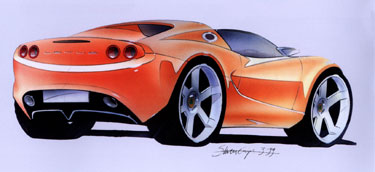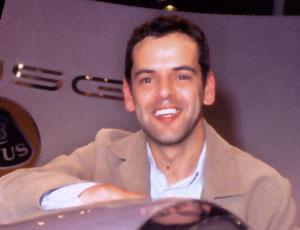
The Dream-Maker: Interview with Steve Crijns
In the latest in our series of profiles on the men who shaped Lotus, Sean Feast caught up with Steve Crijns.
Like most little boys, Steve Crijns loved drawing cars. They nearly always followed a similar theme: sleek; aerodynamic; fast. Cars of the future. Little did he know then, that they were virtually the template of the car for which he has (so far) been most closely associated - the new Lotus Elise.
Born in Belgium, Steve studied Industrial Design before attaining a place at the Royal College of Art for a Masters degree in Vehicle Design. Whilst at the RCA, he first became aware of Lotus,
"Of course I knew of Lotus from James Bond but it was only after I arrived in the UK that I became really aware that there was more to Lotus than the Esprit. The Elan was my particular favourite. it seemed so advanced with its modern graphics and surfaces, just like the cars I used to draw. It really caught my eye."
The fascination led Steve to enquire further. "I wanted to work for a specialist manufacturer that was passionate about what they did. I didn't want to be mainstream - the thought of designing family saloons all day for one of the automotive giants held little appeal."
Steve's wishes came true. Joining Lotus in 1994 he was quickly handed his first task. "We were working on the Esprit GT3," he says, "and my particular task was to look at the interior. My brief was simple. I had to get the car noticed."
And noticed it was. His response to the brief reads like a story that will one day no doubt become the stuff of legend. He made the car orange. But not just the interior. The colour scheme was also carried through to the exterior of the car, and pretty soon after 'his' Esprit was splashed across the front pages of virtually every European car magazine. The response was incredible.
"It was never meant to be a production colour," he laughs, "but people kept asking where they could get hold of one. To see a line of orange Esprits rolling off the production line was quite a sight."

Indeed it was, and earned him some good-natured ribbing from his colleagues. Julian Thompson (Head of Design at that time) nicknamed him 'The Cheeky Belgique', a soubriquet that holds - in some quarters at least - today. "Fortunately most people have gone back to calling me Steve," he jokes.
Other projects soon followed, including designing the new six-spoke wheel for the V8 Esprit, He also began working closely with Russell Carr, Chief Designer at Lotus, on the 340R.
"I executed Russell's sketch into a full-size clay model. It was the first car where we could show what design direction we wanted to take for Lotus. It was clear Russell and I were on the same wavelength, with similar tastes and ideas for the brand."
Then came his star prize. The new Elise.
"It started as a sketch programme in the Studio at the same time we were working on the M250. Russell was working flat out and needed someone who could run with the Elise full time. I was left to get on with it with the team."
Gradually the new Elise design began to take shape - quite literally. They built a one third-scale model out of clay.
"The inspiration for the new Elise came from the old. At first we wanted it to be quite avant garde but refined our thinking to be more timeless, classical. We all liked the design of the original Elise; we didn't want to throw all that away and start again. There was no need. We wanted to improve upon it."
And improve upon it they did. They improved upon the aerodynamics, making the rear spoiler higher and the roof lower, and inserted a completely new back.
"The rear of the MkI was a bit cluttered, and we wanted to do something about it. At the time we were working on a new light cluster that we could use both on the new Elise, the M250 and any potential future models, This proved ideal.
"I also wanted to emphasise that the Elise is a rear wheel drive by increasing the power of the bodywork over the rear wheels. Lowering the bonnet and reducing the waistline accentuates the width at the rear. Also having larger diameter wheels at the rear rather than those at the front helps with this effect.
"in total the design details of the Elise pay homage to the very best elements of the classic sportscar," he says. "Add the design cues from the motorsport world such as the fuel filler cap and the bold treatment of the rear diffuser and the result speaks for itself."
Steve also made other changes, taking inspiration from work already undertaken on the 340R. Even the use of the Lotus badge was addressed.
"The Lotus badge on the rear of the MkI was almost apologetic, buried underneath the lights. We put the words 'Lotus' proudly on the back, between the new light-array, and made a feature out of it," he adds. "In short, we wanted to design a car that when you looked at it, from whatever angle, it was unmistakably a Lotus."
The success of Steve's design is now a matter of record. But the work still goes on. Bringing his time at Lotus up-to-date,
Steve has recently finished his part in the design and launch of the new 160bhp 111 and 111S. Here he has a confession.
"I actually designed the new wheels and the diffuser two years ago," he says. "In automotive design, that's what you have to do. Always think ahead. Always ask 'what next'." He kept the secret well, as he does the work he is currently undertaking for release 'some time in the future.
In terms of ultimate design concepts, Steve shares Russell Carr's recognition of Concorde as being one of the true 'greats'. He also admits to having a passion for boats. "I have worked on a design for a Lotus Sports Boat," he confides, "using the same concept of lightweight materials and attention to detail. There are many similarities between boat design and automotive design; unfortunately they tend to be very separate industries. "A statement that is true enough, but one that hasn't stopped Porsche. Lamborghini, even Rolls Royce getting involved at various stages of motor boat design.
Steve's favourite designer is in fact an architect, Santiago Calatrava, the man behind the World Expo Bridges in Seville and the high highly-acclaimed railway station in Lyons. "It's the tension he creates in his designs, making things happen in concrete that you wouldn't have thought possible," Steve says. "It's so advanced. Daring. Sexy."
And so in 10 or even 20 years time, where does Steve hope to be? "Still designing cars!" he says. "It's never boring. Sometimes I think I'll wake up one day and find that it's all been a dream - a child again, drawing my futuristic cars."
Vive Le Cheeky Belgique!
"There are many similarities between boat design and automotive design; unfortunately they tend to be very separate industries"
"We all liked the design of the of the original Elise; we didn't want to throw all that way and start again. There was no need"
Lotus Life
Lotus Life is the club magazine suppored by Lotus. It contains articles on new cars, history of old cars, and club activities. Sean Feast is the editor and writer. Clare Stasiak (Cstasiak@lotuscars.co.uk) can be contacted for membership information.
June/July 2002
